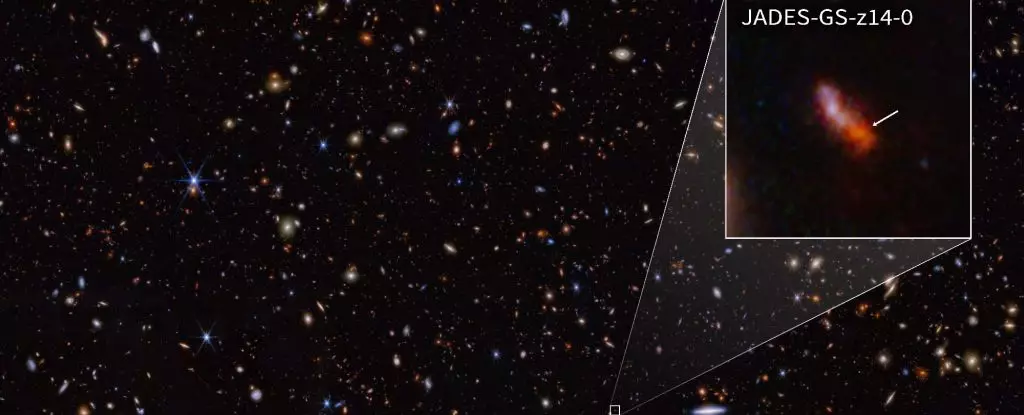A groundbreaking discovery in the field of astronomy has recently been made, with a newly discovered galaxy shattering records for being the earliest seen yet. Known as JADES-GS-z14-0, this galaxy is brightly gleaming in the early Universe, having been observed less than 300 million years after the Big Bang. Another significant finding, dubbed JADES-GS-z14-1, has also been confirmed to be nearly as distant. These detections present a major challenge to current models of galaxy formation, as they are now considered “unambiguous”.
In January 2024, astronomers observed the galaxy JADES-GS-z14-0 using NIRSpec for almost ten hours. The results of this observation revealed that the galaxy was at a redshift of 14.32, breaking the previous record for the most distant galaxy. Moreover, the galaxy was found to be over 1,600 light-years across, indicating that the light emitted is primarily from young stars rather than emission near a growing supermassive black hole. The sheer amount of starlight coming from this galaxy implies that it is several hundreds of millions of times the mass of the Sun, posing the question of how such a massive and bright galaxy could form in less than 300 million years.
Three separate papers have been written on this subject, one of which has been newly published in Nature. The other two papers, available on arXiv, are yet to undergo peer review. However, all three papers reach the same conclusion – JADES-GS-z14-0 represents a significant advancement in understanding how the Universe formed at its inception. This discovery challenges previous assumptions about the Cosmic Dawn, a period in the early Universe following the Big Bang, during which our knowledge was limited due to the presence of a fog of neutral hydrogen that scattered light.
The early Universe eventually transitioned from a foggy state into a transparent one as the neutral hydrogen was ionized by ultraviolet light. This transformation allowed stars and galaxies to form, leading to the need for a deeper understanding of how these structures came into existence. The James Webb Space Telescope (JWST) has been conducting the Advanced Deep Extragalactic Survey (JADES) to study objects within the first 650 million years after the Big Bang. Through its powerful infrared capabilities, JWST has uncovered objects earlier than expected, challenging existing theories about the timeline of galaxy and black hole formation.
The discovery of JADES-GS-z14-0 is particularly significant due to its size, brightness, and composition. The presence of dust and heavy elements like oxygen in the galaxy’s light spectrum suggests the existence of multiple generations of massive stars within the first 300 million years after the Big Bang. This finding contradicts previous beliefs about the timeline of star formation and galaxy evolution, prompting astronomers to rethink their understanding of the early Universe. JADES-GS-z14-0 represents a new archetype that challenges traditional models of cosmic evolution.


Leave a Reply